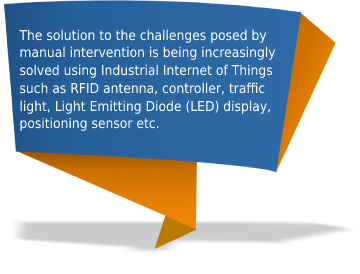The Indian Cement Industry is recognised worldwide for its energy and resource efficient operations. The Indian Cement Industry is looking at a major digital transformation to optimise its supply chain network and production technologies. Emerging demand from infrastructure under the National Infrastructure Pipeline (NIP) projects requires fast track delivery of cement. To cater to this increased pace of development, CMA Member Companies are assessing several technology interventions across the supply chain such as thermal and load sensing technologies, and Radio Frequency Identification (RFID) tags on trucks.1
A major technology enabler in this direction is the Industrial Internet of Things (IIoT), which can enhance logistics efficiency by providing access to real time supply chain information for tracking materials, equipment and products. The system also provides responsive reporting, which allows the Cement manufacturers to collect and feed reported information into their Enterprise Resource Planning (ERP), Product Lifecycle Management (PLM), and other systems for improved data centric decision making.2
In the conventional system when a truck entered the premises of a Cement Manufacturer, the security personnel had to manually check the papers of every vehicle. The condition and fitment of the vehicle to carry cement was also assessed. This often led to trucks being stranded and impacted the dispatch capacity of the plant.3
A challenge was also faced when the trucks entered the weighbridges, which were managed manually. Manual weighing took time and hampered efficiency. It also required the constant presence of manpower to oversee the entire system.4 It led to long waiting hours inside the cement plant leading to waste of fuel, manpower resources and caused traffic jams.5
The solution to the challenges posed by manual intervention is being increasingly solved using IIoT. Many Cement manufacturers have gone ahead with IIoT intervention, which is an Integrated Logistics Management System (ILMS) encompassing their fleet of vehicles, weighbridges and production systems.
IIOT offers a solution that can be adopted across multiple systems, including vehicle fleet management, weighbridges and production facilities. Technologies such as RFID based security windshield stickers can be used on the vehicle fleet. The RFID antenna, controller, traffic light, Light Emitting Diode (LED) display, positioning sensor, camera, and customised software are integrated into the Cement Manufacturer’s Enterprise Resource Planning (ERP) software.6
Video analytics is also engaged by the system. A video camera is deployed on the conveyor belts to count the number of Cement bags passing through using analytics, and thermal and load sensing technologies. The Supervisory Control and Data Acquisition (SCADA) system is linked to this bag counting system, which is further linked to the ERP.7 Once the truck is loaded with cement and leaves the plant, the system tracks it using Global Positioning System (GPS) based software. This provides customers real time updates on their cement delivery.8 Adoption of ILMS has several advantages such as it reduces the turnaround time for truck loading, enhances logistical efficiency and also promotes conservation of resources.9
Cement manufacturers are increasingly recognising the need to drive efficiency across the supply chain. The adoption of IIoT is an initiative in this direction. With an increasing adoption of technology and innovation such as Artificial Intelligence and IIoT, which are a part of Industry 4.0, the Cement Industry is poised for significant technology advancements. This will lead to conservation of national resources and also promote environmental conservation besides of course driving efficiency across the supply chains.10
